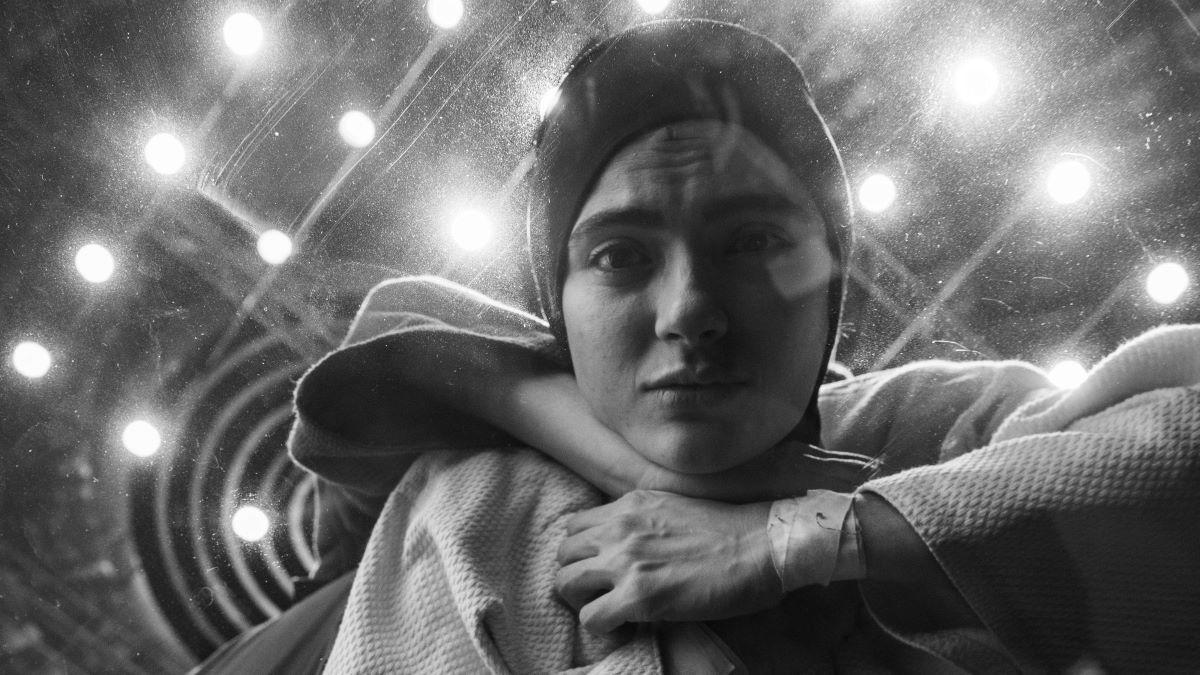by Russ Island
With his film Eraserhead, David Lynch has created what can only be called a surrealistic masterpiece. Uncompromising in style, this black-and-white film is not merely nightmarish: it is a nightmare captured on celluloid. The audience is plunged into a dark, menacing, claustrophobic environment of decay, gloom and nausea with more intensity than anything surrealist cinema or film-noir has yet offered. The eerie symbolism of images Lynch has dredged up from the subconscious is far more disorienting than Polanski’s Repulsion or The Tenant, Jodorowski’s El Topo, or Malle’s Black Moon. Comic relief is minimal and as the heavy depression and the sense of impending doom become more nearly intolerable for the protagonist/victim and the audience, any nervous laughter or guffaws which have been evoked abruptly cease, making Eraserhead a far cry from those sparkling gems by the Grand Master of Surrealist Cinema, Luis Bunuel.
It is difficult to maintain intellectual distance from the film’s haunting dream mythology. Its potency is such that one soon feels he is journeying deep within his very own nightmare. Henry, the protagonist/victim, is a printer “on vacation” who lives in a dingy apartment house (at times reminiscent of scenes in Psycho) located in an industrial wasteland. His apartment seems to be rife with mold, moss, fungus, and grass, along with several piles of soil from broken flower pots and the remnants of dead houseplants (probably he feels too exhausted and depressed to clean up the mess). The flickering lights in the apartment only reveal deeper shadows. The grimy windows are steamed up and the steam radiators hiss and clank. Outside are the noises of trains and storms. Henry’s relief from this cacophony is a record of amusement-park-ride calliope music. He has one special, favorite part of the record which he seeks out each time he plays it. Also, he is given to daydreaming on his rickety bed (a dream within a dream, like The Saragossa Manuscript) about a pasty white, angelic woman in a white dress who might possibly be his own salvation from the frustrating predicament his life has become. She is “pure,” and visions of her come only when Henry stares at the radiator heater; the hissing sound it makes reminds him of the way a theater or music hall audience sounds before curtain-time. The radiator pipes become curtains which part and his Angel, with her cute, upturned nose and grotesquely puffy cheeks, dances on a steamy, tiled stage (just like the tiled floor under the radiator) and sings a lullabye to him (accompanied by calliope music) about how fine things are “in Heaven.”
The three other women in Henry’s life are unsettling in varying degrees and he feels ill at ease around them. The dark haired, demonic sexpot who lives across the black hall is a “man-eater.” At one point Henry sleeps with her—or dreams that he sleeps with her and is pulled down into a pool of muck which appears in the center of his bed, the primordial ooze of sexual lust (as he is absorbed into her libido) or the swamp of sinful sensuality. Henry’s girlfriend Mary is nervous and shy, perhaps an epileptic, or the carrier of potential gross deformities in her genetic code. When Henry is invited over to her parents’ house for dinner, the severe mother accuses him of impregnating her daughter. In this stressful situation, he develops a nose-bleed. Nonetheless, he meekly accepts the responsibility for the thing at the hospital (“Mother, they’re not even sure it is a baby!”) which he has supposedly fathered. Subsequently, Mary and the little monstrosity (which resembles a foetal lamb with no limbs and a torso wrapped in bandages) move in with him. It moans, coughs, and gurgles incessantly, making sleep impossible for the young couple. Eventually, in the middle of a storm, Mary goes back tearfully to her parents’ house (also located in the blighted zone) to get some sleep, and leaves Henry to cope with their “baby,” which suddenly becomes sick without benefit of maternal care. Henry rigs up a vaporizer, but its condition only worsens and hideous sores, perhaps measles, cover its face and neck. Finally, out of curiosity or desperation, Henry cuts open the bandages on the torso with scissors. . .and the audience receives another dose of shocks.
Henry is, of course, a freakish character. A nightmarish environment could only spawn a freak. He finds mechanical devices potentially threatening and communication with his fellow denizens difficult. He moves like a zombie through his bizarre, frustrating encounters, wearing poorly fitting clothes, white socks, a pocket-protector pencil and pen pouch, a worried expression and a “fright-wig” of frizzy hair reminiscent of a pencil eraser. Indeed, the fright-wig hair style is appropriate for someone as paranoid as Henry. In another of the dreams within the dream, Henry imagines himself beheaded and (having fallen into a mud- puddle in an alley) found by a boy who takes it to a factory in the blighted zone where erasers are put on pencils. Naturally, Henry’s head provides A-1 eraser material, a metaphor for existential numbness and the loss of memory and creativity, as if a sort of petrification process had occurred and replaced the precious substance of intelligence in the honeycomb of the mind (or brain) with residual industrial muck. Corrosive modern society tends to transform people into objects, stripping away or leaching out the essential subtleties of being “human.”
With the same perfectly illogical logic of dreams, Henry discovers more of the wriggling, ectoplasmic creatures like his “child” (but at a much less developed, macro-spermatozoan stage) coming out of Mary’s womb while she sleeps in his bed. Horrified, he pulls them out like slimy, squeaky snakes and throws them violently onto the floor and against the walls of the apartment. In the next vision of his singing guardian Angel, she steps on and squashes these squirming, foetal forms (while wearing a sickly smile) as they fall around her onto the stage, in an attempt to eradicate this gross impurity. But when Henry again sees the mysterious sexpot, and she has rejected him (in Mary’s absence) by bringing a man home to her apartment, the audience sees Henry’s feeling of loss and sexual inadequacy manifested by the head of the freak baby rising out of his collar in place of his own head. (At this point, the audience may wonder if he actually is—or fears he is—a fully grown version of one of these creatures.) Henry belongs to a long tradition of out-of-tune “losers” who are eventually destroyed or engulfed by their hostile surroundings, or who must exit via suicide.
The opening sequence of the film shows a deformed attendant with a hideously scarred or eroded face pulling levers which might control the machinery of an amusement park ride, a Kafka-esque carnival of absurdity. He seems to be inside the bowels or womb of Hell, or the bowels of Henry’s apartment, or a small, obscure, crumbling eraser-like planet in a dying galaxy (the credits list the actor in this part as the “man in the planet”). Whatever device or process he activates seems to cause a possibly animate thing (like the ectoplasmic creatures which occur later) to jettison and to plunge through a void, into a pool (or Earth?) and then gradually slide through what may be a hair-rimmed aperture, entering a painfully intense whiteness (the trauma of birth?). Suddenly Henry appears, walking through his symbolic, desolate landscape in bright daylight. The possibilities are fascinating and multiply as the film progresses. Henry’s deformed offspring might be considered a metaphor for what pollution, radiation and miracle drugs may be doing to our environment and bodies; or a projection of an “ineffectual” person’s fears that he or she could not produce normal, healthy progeny. Chemical additives, or an extreme sense of guilt over carnivorous activities, may be responsible for a man-made roast chicken (the size of a fist) which wiggles and spews blood when Henry tries to carve it. Other symbols in the film are more subtle and mysterious, such as the tiny seed or piece of dried, exotic (alien?) food or medicinal root which someone has left in his mailbox in the stark lobby. Who can tell with a character who keeps a bowl of water in the same bureau drawer with clothing and a torn-in-half photo of his girlfriend?
Like most of the best works of art, Eraserhead is open to numerous interpretations because it is not merely a randomly juxtaposed collection of images. One might say that David Lynch was being too “self- indulgent” by making this sort of underground “personal film”; actually he has proven that the vagaries and obscure connections of the shadowy subconscious mind can be accurately and even brilliantly transmuted into an artform to which anyone interested in dreams can relate. If nothing else, those daring thrill-seekers brave enough to view Eraserhead from beginning to end can enrich their own nightmares with deeply disturbing grotesquerie of the finest quality.
Cinemonkey, Spring 1979 Volume 5, Number 2; pp. 56-57




